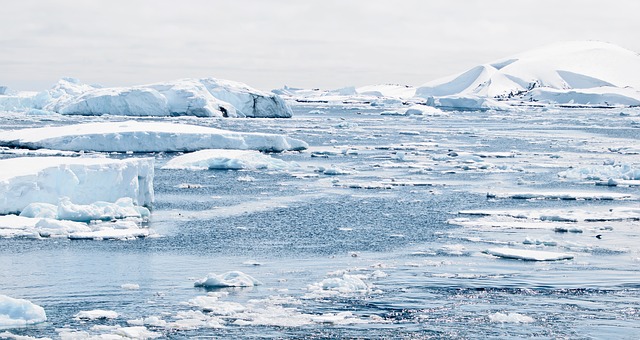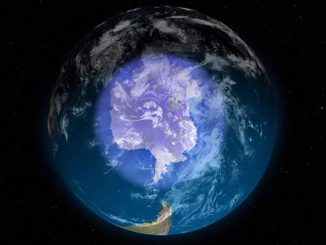
If you follow weather news, you likely heard that this winter brought the lowest seasonal extent of Arctic sea ice on record – but it may still be news to you that most of the missing ice isn’t missing from the Arctic.
The satellite data collected by the National Snow and Ice Data Center, extending back to 1979, treats all northern hemisphere sea ice as “Arctic” sea ice. In summer and early autumn, this description is accurate. Once the ice melts out of Hudson Bay (most of which lies well below the Arctic Circle), what is left is an ice cap that floats with the generally circular currents in the Arctic Ocean, bounded by the northern reaches of North America, Scandinavia and Siberia.
But in late autumn and winter, the northern ice expands dramatically. Hudson Bay refreezes early, often sometime around Christmas. So does much of the Bering Sea north of the Aleutian chain. Ice creeps down the eastern coastlines of Labrador and Greenland and begins to surround the island of Newfoundland.
Parts of the Baltic Sea will typically freeze, earliest in the east. Ice always appears in the Sea of Okhotsk along the southeastern Siberian shoreline, and as the season progresses the ice typically does as well, to surround the northern Japanese island of Hokkaido, sometimes extending southward to the portion of Honshu north of Tokyo.
Back here in North America the ice will, in some years, just about fill the Gulf of St. Lawrence. It can extend further south as well. In really cold years, Chesapeake Bay may freeze – bringing “Arctic” sea ice to the shoreline of the old Confederacy. One place Arctic ice never appears, however, is on the Great Lakes. Even when Lake Erie is entirely frozen over, that ice does not count, because the lakes are freshwater.
So when we hear about the record-low Arctic ice cover, we ought to ask ourselves: Where is all the missing ice? (And resist the temptation to answer: “Nowhere, because it’s missing.”)
The current maps from the NSIDC show that the ice is missing from seemingly everywhere. In the Arctic basin itself, the ice cover stops well short of its historic average position in the Kara Sea, which lies east of Finland and north of Russia’s Kola Peninsula. Ice cover has been notably absent in the Kara Sea and the adjacent Laptev Sea to the east for several years now, and the unusual extent of open water has significant implications for Northern Hemisphere weather patterns – but generally cold implications, which I will discuss in a little bit.
The ice is scanty, also, along the northeast shore of Siberia north of the Kamchatcka Peninsula, in the western Bering Sea, in the Gulf of St. Lawrence and in the Baltic region. It is well short of average in the Sea of Okhotsk. It is near average along the Labrador and Greenland coastlines, and above average only in a couple of small and isolated spots east of Newfoundland and southwest of Alaska. Another place seeing more ice than usual is the northern and central coastline of China – the equivalent, in its more southerly stretches, of ice appearing in Chesapeake Bay.
Other than the Kara-Laptev Sea region, these are regions where ice frequently appears in mid- to late winter and always melts out in the spring. Even in the more northerly stretches, such as the Bering Sea and the Greenland and Labrador coasts, this seasonal growth and disappearance of sea ice contributes nothing to the polar ice cap and its role in regulating and driving global climate. Other than for shipping interests and wildlife management (this is the season for the notorious Canadian harp seal hunt), this nonpolar ice is insignificant in the broader scheme of things. Also, the relatively short period of the satellite record provides only limited context, even for the extent of the summer ice declines in the polar region – which arguably has leveled off in the past decade after sharp falls in the previous 15 years.
The NSIDC also reports that air temperatures in the Arctic basin were well above normal this winter, and the National Oceanic and Atmospheric Administration has announced that the winter was the sixth-warmest in records going back to the 19th century across North America. What should we make of that?
To start, the unusual expanse of open water in the Kara Sea region was a large contributor to the polar warmth, as the mild water provided a heat source in the long winter nights. But there is a direct relationship between warm polar weather and cold outbreaks in the middle latitudes. This relationship, the Arctic Oscillation, helps determine the strength and location of the polar vortex, which often brings severe cold when it is dislocated southward.
There were numerous cold outbreaks this winter – just not in the eastern two-thirds of North America or in northwestern Europe. Our Pacific Northwest is emerging from a memorably harsh winter. Cold weather invaded southeastern Europe and the Middle East, which made life even more miserable for those displaced by war in Syria and Iraq. For the third year in a row snow cover started early and advanced rapidly across northern and central Asia, and this was a very cold winter in that area too – which provided a source region for the frigid weather that produced the ice along China’s coast.
The cold weather in Asia may have contributed to a strong jet stream across the Pacific, which drove record rainfall into California, rebuilt the Sierra snowpack and flooded much of the rest of our continent with mild maritime air. Remember all those news stories that attributed California’s recent five-year drought to global climate change? That was always, at best, a gross oversimplification. The just-ended winter showed why and how. In climate and weather, everything interacts with everything else. We are still learning a lot about how those interactions work.
So does the limited ice cover at winter’s end mean an exceptionally small ice pack is a foregone conclusion this summer? Not at all. As I said, most of the missing ice is in places where there would be no summer ice anyway. Given recent trends and the Arctic warmth this winter, which probably meant thinner ice growth, it will be no surprise to see a lot of open ocean in the Arctic by summer’s end, but not necessarily much different than has been the case in recent years. Now that the sun has risen for the next six months at the North Pole, we’ll just have to wait to see what Nature plans to do.




Leave a Reply